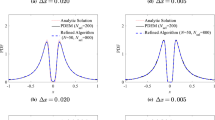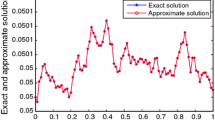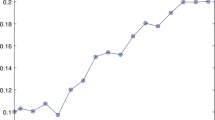Abstract
The development of the generalized probability density evolution equation (GDEE) provides a new direction for analyzing stochastic dynamical systems. In particular, it offers an effective solution for nonlinear problems. In this paper, a multiresolution adaptive grid method (MAGM) is proposed for the numerical solution of the GDEE. In this method, the size of multiresolution adaptive grids, which are constructed based on the second-generation wavelet transform, can be dynamically adjusted according to the change of the probability density function (PDF). Besides, the MAGM, which combines the spatial discretization scheme WENO-Z and the temporal discretization scheme third-order TVD Runge–Kutta, ensures the accuracy of the PDF. The method's advantages and accuracy are verified by analyzing a single-degree-of-freedom system, a two-dimensional frame structure, and a three-dimensional frame structure. The adaptive grids can capture the local singularity of PDF and provide more details for local mutation areas. Moreover, the algorithm configures fewer grid points in the region with high regularity to speed up the calculation efficiency.


























Similar content being viewed by others
References
Ju, P., Li, H.Y., Pan, X.P., Gan, C., Liu, Y., Liu, Y.L.: Stochastic dynamic analysis for power systems under uncertain variability. IEEE Trans. Power Syst. 33, 3789–3799 (2018)
Chandra, S., Sepahvand, K., Matsagar, V.A., Marburg, S.: Stochastic dynamic analysis of composite plate with random temperature increment. Compos. Struct. 226, 111159 (2019)
Ni, P.H., Xia, Y., Li, J., Hao, H., Bi, K.M., Zuo, H.R.: Multi-scale stochastic dynamic response analysis of offshore risers with lognormal uncertainties. Ocean Eng. 189, 14 (2019)
Shinozuka, M.: Monte Carlo solution of structural dynamics. Comput. Struct. 2, 855–874 (1972)
Wang, X.-Y., Cen, S., Li, C.F., Owen, D.R.J.: A priori error estimation for the stochastic perturbation method. Comput. Method. Appl. M 286, 1–21 (2015)
Lin, J.H., Zhang, W.S., Williams, F.W.: Pseudo-excitation algorithm for nonstationary random seismic responses. Eng. Struct. 16, 270–276 (1994)
Vadlamani, S., Arun, C.O.: A stochastic B-spline wavelet on the interval finite element method for problems in elasto-statics. Probab. Eng. Mech. 58, 102996 (2019)
Vadlamani, S., Arun, C.O.: A stochastic B-spline wavelet on the interval finite element method for beams. Comput. Struct. 233, 106246 (2020)
Vadlamani, S., Arun, C.O.: A perturbation-based stochastic nonlinear beam element formulation using the B-spline wavelet on the interval finite element method. Acta Mech. 232, 4987–5001 (2021)
Falsone, G., Laudani, R.: A probability transformation method (PTM) for the dynamic stochastic response of structures with non-Gaussian excitations. Eng. Comput. Swansea Wales 35, 1978–1997 (2018)
Falsone, G., Laudani, R.: Matching the principal deformation mode method with the probability transformation method for the analysis of uncertain systems. Int. J. Numer. Methods Eng. 118, 395–410 (2019)
Laudani R, Falsone, G.: Use of the probability transformation method in some random mechanic problems. ASCE-ASME J. Risk Uncertain. Eng. Syst. Part A Civ. Eng., 7, 04020054 (2021)
Tootkaboni, M., Graham-Brady, L.: Stochastic direct integration schemes for dynamic systems subjected to random excitations. Probab. Eng. Mech. 25, 163–171 (2010)
Li, J., Chen, J.B.: Probability density evolution method for dynamic response analysis of structures with uncertain parameters. Comput. Mech. 34, 400–409 (2004)
Xiao, X., Yan, Y., Chen, B.: Stochastic dynamic analysis for vehicle-track-bridge system based on probability density evolution method. Eng. Struct. 188, 745–761 (2019)
Zheng, Y.: Predicting stochastic characteristics of generalized eigenvalues via a novel sensitivity-based probability density evolution method. Appl. Math. Model. 88, 437–460 (2020)
Yu, Z.W., Mao, J.F., Guo, F.Q., Guo, W.: Non-stationary random vibration analysis of a 3D train-bridge system using the probability density evolution method. J. Sound Vib. 366, 173–189 (2016)
Li, J., Chen, J.B.: The number theoretical method in response analysis of nonlinear stochastic structures. Comput. Mech. 39, 693–708 (2007)
Chen, J.B., Yang, J.Y., Li, J.: A GF-discrepancy for point selection in stochastic seismic response analysis of structures with uncertain parameters. Struct. Saf. 59, 20–31 (2016)
Papadopoulos, V., Kalogeris, I.: A Galerkin-based formulation of the probability density evolution method for general stochastic finite element systems. Comput. Mech. 57, 701–716 (2016)
Tao, W.F., Li, J.: An ensemble evolution numerical method for solving generalized density evolution equation. Probab. Eng. Mech. 48, 1–11 (2017)
To, C.W.S.: The stochastic central difference method in structural dynamics. Comput. Struct. 23, 813–818 (1986)
Li, J., Chen, J.B.: Dynamic response and reliability analysis of structures with uncertain parameters. Int. J. Numer. Methods Eng. 62, 289–315 (2005)
Lin, Y.M., Xu, C.J.: Finite difference/spectral approximations for the time-fractional diffusion equation. J. Comput. Phys. 225, 1533–1552 (2007)
Meerschaert, M.M., Tadjeran, C.: Finite difference approximations for two-sided space-fractional partial differential equations. Appl. Numer. Math. 56, 80–90 (2006)
Yuste, S.B., Acedo, L.: An explicit finite difference method and a new von Neumann-type stability analysis for fractional diffusion equations. SIAM J. Numer. Anal. 42, 1862–1874 (2005)
Castro, M., Gallardo, J.E.M., Pares, C.: High order finite volume schemes based on reconstruction of states for solving hyperbolic systems with nonconservative products. Applications to shallow-water systems. Math. Comput. 75, 1103–1134 (2006)
Dumbser, M., Enaux, C., Toro, E.F.: Finite volume schemes of very high order of accuracy for stiff hyperbolic balance laws. J. Comput. Phys. 227, 3971–4001 (2008)
Sweldens, W.: The lifting scheme: a construction of second generation wavelets. SIAM J. Math. Anal. 29, 511–546 (1998)
Song, X.D., Zhou, C.K., Hepburn, D.M., Zhang, G.B., Michel, M.: Second generation wavelet transform for data denoising in PD measurement. IEEE Trans. Dielectr. Electr. Insul. 14, 1531–1537 (2007)
Vasilyev, O.V., Bowman, C.: Second-generation wavelet collocation method for the solution of partial differential equations. J. Comput. Phys. 165, 660–693 (2000)
Borges, R., Carmona, M., Costa, B., Don, W.S.: An improved weighted essentially non-oscillatory scheme for hyperbolic conservation laws. J. Comput. Phys. 227, 3191–3211 (2008)
Balsara, D.S., Shu, C.W.: Monotonicity preserving weighted essentially non-oscillatory schemes with increasingly high order of accuracy. J. Comput. Phys. 160, 405–452 (2000)
Shu, J.C.W.: Efficient implementation of weighted ENO schemes. J. Comput. Phys. 26, 202–228 (1996)
Gottlieb, S., Shu, C.W.: Total variation diminishing Runge–Kutta schemes. Math. Comput. 67, 73–85 (1998)
Takeda, T., Sozen Mete, A., Nielsen, N.N.: Reinforced concrete response to simulated earthquakes. J. Struct. Div. 96, 2557–2573 (1970)
Kent, D.C., Park, R.: Flexural members with confined concrete. J. Struct. Div. 97, 1969–1990 (1971)
GB50010-2010.: Code for design of concrete structures. Beijing: National Standards of the People’s Republic of China, China Architecture & Building Press (2010)
Acknowledgements
The research is financially supported by the National Natural Science Foundation of China (Grant No. 51878274).
Author information
Authors and Affiliations
Corresponding author
Additional information
Publisher's Note
Springer Nature remains neutral with regard to jurisdictional claims in published maps and institutional affiliations.
Rights and permissions
About this article
Cite this article
Wang, T., Zhang, X. & Yang, S. A multiresolution adaptive grid method for solving the generalized probability density equation in stochastic dynamic analysis. Acta Mech 233, 1911–1940 (2022). https://doi.org/10.1007/s00707-022-03183-w
Received:
Revised:
Accepted:
Published:
Issue Date:
DOI: https://doi.org/10.1007/s00707-022-03183-w




